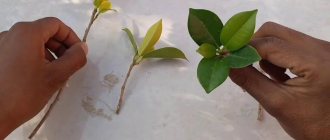Ficus is one of the few house plants that can be found in almost every living space. This popularity is due to its attractive appearance, as well as ease of care. In addition, there is a belief that ficus promotes family well-being, as well as the birth of children in the family. If you saw someone's gorgeous ficus Benjamin while visiting, you will definitely want to grow something similar at home, which is why you need to know how to plant a ficus shoot.
Rules to help you choose a healthy shoot
If you want to independently separate a shoot from a ficus, then you need to choose only strong and healthy plants, for example, you can take a cutting when cutting the crown of an adult ficus. However, before doing this, you need to make sure that the selected branch has leaves. The length of the process should be at least 10-15 centimeters. All actions must be performed with a sharp knife or blade. The cut must be made at an oblique angle. And under no circumstances should you use scissors, much less break a twig, as you will only injure the plant, which will result in delayed rooting and further development.
If you have chosen a large-leaved species for cultivation, then in order to grow a flower at home, it is enough for the cuttings to have 3-4 leaves. In this case, it is advisable to trim the lower one, since a large number of leaves will contribute to excessive evaporation of moisture. When growing small-leaved ficus, the lower leaves also need to be trimmed, but their number can be more than 3-4.
After the procedure of trimming the leaves and the shoot itself, the plant can release white sap. If you don't wash it with water, it dries out very quickly. This cannot be allowed. Therefore, after the shoot is cut, the juice should be washed off with warm water or placed in a container with water for several hours. It is also recommended to treat the cut area with charcoal.
Before planting a ficus shoot, you need to dry it or simply change the water several times. There are two methods of planting: cuttings from roots and without them.
Methods of pruning
Sometimes gardeners resort to cutting branches. It is important to take into account that thin branches are cut straight, while thick branches are cut at an angle. Tools for manipulation must be clean so as not to introduce any infection that will lead to the death of the flower. It is recommended to use alcohol as a disinfectant. In addition, you can also heat the tool on fire.
The released juice must be removed immediately; this can be done with a regular napkin. After one month, the flower is fed and transplanted into a looser pot.
Important! Ficus sap is poisonous, so do not touch it with bare hands; you should wear gloves.
How to root a shoot correctly
Previously, it was said how to properly separate a shoot from an adult plant so that the ficus grows healthy. But this is not enough. It is also necessary to properly root the prepared cuttings into the ground. However, there are ways that will tell you how to plant a ficus shoot without roots.
The cutting should be planted immediately after it is separated from the adult plant. To do this, you need to prepare a mini-greenhouse, which should have good lighting, and also purchase some fertilizer. Plant the stem in the prepared soil, then cover it with a glass jar or cut plastic bottle. During the rooting period, the plant must be looked after. Care consists of regular watering and ventilation of the plant. Within 2-3 weeks the first leaf will appear, which is direct evidence that the cutting has taken root. Then you don’t have to replant it.
How to replant Ficus Benjamin: detailed process of replanting ficus
Replanting a ficus improves the vital activity and productivity of the plant. Young plants must be replanted annually, after reaching the age of four - once every 2 years. The main signs of the need for a transplant:
1 4
- the ground dries out quickly;
- the leaves turn yellow and the trunk becomes bare;
- the roots do not fit in the pot, stick out on the surface and emerge from the drainage hole.
You can replant a flower from a transport pot after 2-3 weeks, so it will better adapt to the environment
One of the reasons for the need to replant ficus benjamina is the falling leaves
An original composition of ficus trees in a spacious hall
How to replant ficus benjamina after purchase? In order for the plant to quickly and less painfully adapt to new conditions, replanting is carried out exclusively in the spring-summer season. In this case, a new container for the plant is selected in diameter 3-4 cm wider than the previous one. You shouldn’t take a pot that’s too wide right away - the ficus will look unsightly, and after replanting it will grow more slowly: the wider the pot, the slower the roots grow. The root system should fit freely in the new container. For young plants, light soil is better suited - a mixture of equal parts of turf and leaf soil, to which one part of sand must be added.
1 4
A beautiful, bright, small pot will help keep the ficus at the required height
Ficus benjamina is very popular as a houseplant and is also grown in bonsai style.
Ficus transplantation is carried out no earlier than two weeks from the date of purchase to give the plant time to adapt
Consider the sequence of transplanting Ficus Benjamin:
- before replanting, the plant must be well watered - this will make it easier to remove it from the old pot;
- carefully remove the top layer of soil;
- Place a drainage layer in a new pot and sprinkle it with soil;
When replanting a ficus, the roots are completely cleared of transport soil.
The pot is taken according to the size of the root system - this makes it easier to regulate watering
The soil must contain sand, and you can also add a little crushed charcoal
- remove the plant, carefully shake off the soil from the roots and transfer it to a new pot;
- add fresh soil evenly on all sides, while maintaining the planting level - it should remain the same.
How to choose a pot for a plant
The choice of pot is one of the important factors, since if you choose the wrong shape and volume, in particular, the ficus will not be able to fully develop. Therefore, before planting a ficus shoot, it is recommended to make a choice based on the size and degree of development of the roots. The container should not be too large; to plant a shoot, it is better to take a pot with a diameter of no more than 10 centimeters, and you need to make sure that there are drainage holes at the bottom. If there are none, then you need to make them yourself. The height of the pot should not be small; the roots should be at least 2 centimeters higher from the walls and bottom of the vessel.
When and how to transplant to another pot
It is best to transplant Ficus Benjamin at home in March or April. Young specimens need replanting annually, and adults – once every three to four years. In between, remove the top layer of substrate from the pot and replace it with fresh one.
Replant your ficus as follows. Take the flower out of the old pot with a lump of earth and, using the transfer method, place it in the center of the new pot, where a layer of drainage and a layer of new substrate have already been laid. Fill the voids between the plant and the walls of the pot with soil, shaking the pot slightly. If the room is hot, lightly water the transplanted ficus and spray its crown with a fine spray bottle. If the room is cool, it is better not to water the transplanted plant for a couple of days.
Young Ficus Benjamin bushes should be checked frequently for rapid root growth. To do this, turn the pot over and look at its bottom. The roots may already be peeking out of the drainage holes. If so, rejoice, you got a fast-growing specimen. Without waiting until next spring, you will have to transplant it into a new, slightly larger pot.
What kind of pot do you need?
Choose a clay or ceramic pot for ficus benjamina. The new pot should not be too bulky, just a little larger than the old one. Then the root system of the flower will quickly cope with the development of the entire volume of new soil, and the flower will more easily take root in the new place
Let us immediately pay attention to the size of the pot for creating ficus bonsai - it should be wide and shallow
Suitable soil
The natural habitat of Ficus Benjamin is the humid tropics with their characteristic moisture-absorbing nutritious soil. When growing indoors, you need to buy or prepare a substrate yourself that is similar to its natural composition. For Ficus Benjamin, purchased soil for decorative foliage plants is suitable. You can use the soil for Mulberry plants or Palm trees. Note that ficuses are not very picky about the composition of the soil.
It is only important that it is nutritious, breathable and has neutral acidity. Self-prepared soil should be like this: a mixture of peat, garden soil and sand in equal parts
You can add a little wood ash to eliminate the acidity of the soil. Adult specimens require a denser substrate, so turf soil and humus should be added to this soil composition.
Step-by-step instruction
The best time to plant a ficus shoot is spring; summer sunny weather is better for rooting and subsequent adaptation of the plant. If the shoot is planted in the fall, the young plant will not have time to prepare for winter frosts and may simply die.
Before planting a ficus benjamina shoot, you need to select a cutting 10 centimeters long, which has previously been rooted into the ground. Further, all actions occur in several stages:
- Prepare all the necessary materials described earlier.
- Place drainage at the bottom of the pot to avoid excess moisture in the soil, since a large amount of water can lead to rotting of the roots.
- Fill the pot with the prepared earthen mixture, then make a small depression in the center, about one and a half to two centimeters high.
- Place the rooted cuttings in this hole and sprinkle a little with the mixture, then water generously.
Now the ficus can be placed on a windowsill or a special flower shelf, and the plant also needs special care to keep it healthy.
Features of caring for cuttings
After you have successfully planted a ficus shoot, the plant will require careful care, in particular, it needs to be sprayed with water at room temperature every day, especially if the apartment is heated. It is better to place the pot with the plant in a bright place, since the leaves will be better colored in this case, but the light should be indirect.
Knowing how to properly plant a ficus shoot is not enough without knowledge about care. Watering with soft warm water is required twice a week. Before each subsequent watering, you need to make sure that the soil is slightly dry, since excess moisture can lead to rotting of the roots, and also because the leaves will fall off. The roots themselves should not be allowed to be in water, but there should also not be a lack of moisture, since the protective reaction in this case would be to completely get rid of the leaves.
If you plant three ficus shoots in a pot, then as they grow, you can give them a rather attractive shape, for example, braid several young plants at once. You can force the ficus to branch in the direction you want; to do this, just use a soft wire and tie the stem to it.
When growing, remember that ficus benjamina can be affected by mealybugs and scale insects. However, the biggest problem remains leaf fall, which can occur due to lack of moisture and moisture, as well as as a natural process as it matures.
If you pay due attention to the ficus, then in just a few years ficus Benjamin will grow on your windowsill, which you can give to any shape.
Ficus is a common indoor plant, which has more than 30 varieties. In order for the plant to have an aesthetic appearance, as well as for health and reproduction purposes, pruning is carried out annually. How to trim ficus
and when is the best time to do this, this article will tell you. Pruning must be carried out correctly and only during the period of active growth of the ficus, in this way you can form the crown of the plant and give it the desired shape.
Methods for forming the crown of rubber ficus
Ficus can be given different shapes. Its choice depends on aesthetic preferences, as well as the size of the tree.
Stamb
The stem of the plant is exposed in the lower part from excess leaves and young shoots. If the pot with a flower is on the window, about 40 cm are exposed, and if on the floor - 90 cm. In the upper part of the flower, 10 cm is cut off. Thanks to this, upward growth is stopped, accelerating the lateral one.
Stamb
Having chosen the required height, the lateral branches from the side of the outer bud are pinched so that growth occurs parallel to the stem and the ficus branches to the sides. In this way, a standard type of crown is obtained.
Bush
The bush shape of the crown can be formed in several ways. In the first method, the flower is allowed to grow to 80 cm, after which 10-15 cm of the top are cut off. Side shoots need to be pinched if they have reached 10 cm. Pruning the stem helps to activate the growth of the side part, due to which the side part grows intensively, forming a voluminous crown.
When using the second method, the plant is provided with constant high humidity. As a result, aerial roots are formed on the stem, which are directed into the substrate. Once the roots sprout and take root, they take on the shape of a banyan tree. Regularly trim excess roots and branches.
Bush
Arc
First of all, to form an arc, it is necessary to allow the plant to grow to the required height, after which the top of the tree is cut off. Thus, all forces will be directed to the growth of the plant in the lateral direction.
Arc
In order to get a voluminous crown with arched edges, you need to bend and secure the side shoots. In this position, the outer buds of the upper part of the stem are activated and begin to actively grow. The fixation from the shoots is removed after the plant has acquired the desired size and shape.
Spiral
The essence of the method is to secure a support in the pot, it can be a rod or a stick. The stem of the plant is wrapped around the support, having previously freed its lower part from leaves and shoots so that the result can be better seen.
Spiral
The entwined stem is firmly tied to the support. At the same time, side branches and shoots are constantly trimmed so that they do not stick out.
Scythe
The spit shape is formed when the plant is still young. The dimensions should not exceed 15-18 cm. To do this, you need to plant 3 young shoots in one pot and wait until each of them grows to a height of 18 cm.
Scythe
After this, the stems begin to be woven into a braid, secured with fishing line and thread. The top layer of skin is completely removed from the intertwined parts of the stem, and the released juice is removed. The stem is fixed as it grows.
Fence
To form a fence or hedge, the plant must be pruned. The cut off shoots are saved and rooted in a large shallow container, preferably a box, in one row. The top layer of bark of growing young plants is cut off, the released juice is wiped off and the stems are connected, tying them together. The rate at which the stems grow together depends on the amount of light in the room.
Why is pruning needed?
The purpose of pruning can be different, it depends on many factors: the age of the plant, its condition and appearance. There are main reasons for which it is recommended to prune ficus:
- formation of a certain crown shape;
- stimulation of plant growth and rejuvenation;
- elimination of elongated stems and baldness of the trunk;
- removal of dry, old and diseased branches.
Ficus, which is periodically pruned, has a beautiful thick crown, it develops immunity to various diseases, and some varieties can be grown into bonsai.
Trimming tools
To carry out the procedure, you must use sharp instruments; at home, for this purpose you may need:
- large and small garden shears;
- pruner;
- sharp knife.
It must be remembered that the cut must be smooth and neat; improper pruning can cause bacterial or viral disease of the ficus. Thin shoots are cut with scissors, the cut is made even, if an adult plant with thick branches is pruned, then the cut must be made beveled; it is recommended to do it with a sharp pruner.
Attention! In the spring, not only pruning is carried out, but also replanting, but before the plant is replanted, it should be pruned and replanted after two weeks. These two procedures are not carried out at the same time; the plant will receive severe stress and may get sick.
All cuts must be treated with disinfectants; crushed charcoal or activated carbon can be used for this purpose. It is recommended to wipe tools with alcohol.
Time to trim
To form the crown and activate the growth of the ficus, pruning is carried out in spring or summer, at the same time elongated branches are removed. It is better to trim indoor plants in March, at the same time the plant needs to be replanted.
During the autumn months, it is not recommended to prune ficus trees unless absolutely necessary. The plant will need the strength and supply of nutrients that it has accumulated during the warm season in order to survive the winter. In the winter months, ficus growth stops, and if you cut off the shoots, new branches will grow only in the cut areas, and the crown will turn out to be one-sided.
In autumn and winter, you can trim only shoots affected by the disease or remove a dry branch, following all recommendations and precautions. If the ficus has just been transplanted, no pruning is carried out; you must wait at least two weeks, but damaged or dried branches must be removed immediately.
What to feed
Ficus benjamina needs feeding from spring to autumn. The frequency of fertilizing at different times is different. In March–April, it is enough to feed the plant once a month. In June, ficus grows actively. And you will have to feed it more often - once every 2 weeks. And so on until September. In the autumn months, again reduce feeding to once a month, but in winter there is no need to feed - let it rest. Nutritious soil guarantees the successful growth of the plant, the beauty of its trunk and the bright color of the leaves.
Organic and mineral compounds and plant compost mixtures act as fertilizers. You can purchase a special fertilizer for ficus plants or a complex fertilizer for decorative deciduous plants in the store. Fertilize according to the instructions included with them, do not overdo it with doses, even better, pour more water than indicated there. Choose fertilizers with a high nitrogen content, as it has a good effect on the growth of green mass of the plant. You can also feed Ficus Benjamin using a spray bottle (foliar feeding). To stimulate the growth of new branches, the drug “Epin” is diluted, and “Ferrovit” is used when the plant lacks iron, and its young leaves acquire a yellowish tint.
We can also recommend you traditional time-tested recipes: dilute 1 tbsp. l. sugar in 1 liter of warm boiled water. Pour this solution generously over your ficus (and a couple or three other flowers, if there is excess solution left). Two sweet feedings over the summer are enough. Glucose is an excellent source of energy for the life processes of all plants. Ficus is no exception.
How to trim ficus
It is recommended to form the crown of an adult plant; a young ficus is usually in the active growth phase and does not need additional procedures. The top should be shortened if the ficus has grown to 70 cm. Several methods are used to form the crown, which depend on the type of ficus. Pruning ficus benjamina
can be carried out several times a year.
Note! The rubber-bearing ficus grows only upward; this must be taken into account when forming the crown. If pruning is not carried out, the ficus will stretch to the ceiling, leaving the trunk below without foliage.
Pruning recommendations:
Ficus pruning photo
- apical shoots are cut no more than 10-12 cm, otherwise the growth of the plant may stop;
- pruning ficus benjamina
is carried out symmetrically; if the side shoot on the right has been cut, you need to cut off the shoot on the left at the same level, otherwise the bush will turn out to be one-sided; - When pruning ficus, it is recommended to wear gloves; the milky sap that the plant secretes, if it gets on the skin, can cause irritation or an allergic reaction.
Lighting and location
Ficus Benjamina is a light-loving plant. However, we note that varieties with monochromatic dark leaves are best placed in partial shade, while those with light leaves are best placed in diffused light. But variegated varieties, whose leaves contain few green cells containing chlorophyll, will not be able to fully synthesize sugar without bright sunlight. Their illumination should be above average.
The best place for a flower to live would be a wide window sill on a window facing southeast, or a place on a bedside table near the south window. The north side is suitable only for ficus varieties with solid green leaves, and only in the summer. At other times of the year, additional lighting will be required. There is a lot of bright sunlight on the southern windows, but at noon the hot sun will burn the leaves of the flower.
Ficus needs direct sunlight in the morning, before 11, and in the evening, after 17. But only adult specimens can withstand the midday sun, and even then not all of their species. It is better if a light curtain hangs on the window at this time. Young plants should be accustomed to sunlight gradually. In autumn and winter, all types of ficus should be placed closer to the sun. On short days, any ficus needs additional lighting, otherwise its leaves will crumble, and in variegated varieties they will also lose their bright color.
Green species tolerate partial shade more easily, but they cannot remain without sunlight for a long time - their growth will slow down, the crown will become one-sided with elongated, faded branches. If the pot is located far from the window, somewhere in the corner of the room, it simply needs an additional artificial light source, for example a fluorescent lamp, which should be attached somewhere above at a distance of no closer than 70 cm from the crown.
It is still advisable to move Ficus Benjamin twice a year: in the summer to the open air, and with the onset of cold weather - back to the house.
Try to find a place on a balcony, loggia or terrace so that its lighting conditions and air temperature do not change much. The ideal place to live for the summer would be the outer wall of the window, near which the pot stood in the apartment in the spring. We do not recommend placing the flower on the south side - it is too hot there.
Useful tips for care after pruning
If pruning is done correctly, the plant looks neat and gives the impression that it has not been touched at all. To prevent the ficus from getting sick, it is necessary to periodically inspect the plant for bacterial infection and follow some recommendations:
ficus after cropping photo
- A freshly pruned plant should not be sprayed; moisture that gets on the cuts can provoke the development of the disease;
- do not place the pot with ficus in a draft or in a cold room, the temperature should not be lower than room temperature;
- do not over-moisten the soil;
- Be sure to feed the plant; in the spring this can be done immediately after pruning.
If you follow all the rules and recommendations, after pruning the ficus will form a crown of the desired shape, but in order for this shape to be maintained permanently, pruning must be carried out regularly, with an interval of 2 months.
Ficus is a plant loved by many gardeners, which has one feature: it only grows upward. Specimens growing in natural conditions can reach a height of forty meters. In apartment walls, owners often have a question: how to prune a ficus tree so as not to harm it. Some novice gardeners argue about how useful such manipulations are for the plant. Experts say that a procedure such as ficus transplantation and root pruning is an integral part of caring for this species.
It allows not only to form a tree of an original shape, but also to rejuvenate the crop.
How often to replant ficus benjamina
In the first years of life, the plant grows roots and crown especially actively. Ficus benjamina is no exception, especially since in nature it can grow into a huge tree. For this reason, a plant under four years old needs to be replanted every year: it becomes cramped in the old pot, and during this time the soil has time to deplete. When the plant is already old enough and its growth begins to slow down, you can replant it not so often, but at intervals of 2-3 years. A completely mature ficus is transplanted even less often.
Experienced gardeners advise not to disturb adult ficus plants with transplantation, so as not to injure the root system. As a rule, a plant aged six years or older is already in a fairly large container - a tub or pot, so you can limit yourself to carefully replacing the top layer of soil.
Pruning and replanting the plant
Before pruning and replanting the ficus, it is necessary to assess the condition of the plant and determine whether it requires preliminary sanitary pruning of dry and non-viable shoots. It is also necessary to remove diseased branches. Sanitary pruning can be carried out at any time.
Proper formation of the plant will allow you to achieve unexpected results. In the skillful hands of a professional, these specimens can grow in the form of an arch or a bush, a trunk or a bonsai. However, each type of ficus has its own specific rules and nuances of the procedure. Therefore, it is very important for beginners in this business to inquire about the characteristics of a particular species before pruning a tall ficus. Before you start pruning, you should decide on the desired result.
You need to know in advance how to properly prune a certain type of ficus so that it has a branched crown and a powerful trunk, or becomes a small lush bush.
Preparing ficus for pruning
Proper crown formation requires knowledge of plant physiology. The ficus produces new shoots from the buds at the top and axils. The axillary ones are located where the petioles are attached to the trunk. Usually, developing much more intensively, the apical bud inhibits the activity of the others. In order to best stimulate their growth, it is important to determine when to prune the ficus and what period will be most successful for the plant’s life cycle. In spring, this flower receives the greatest amount of strength. It is during this period that pruning allows you to realize your ideas more successfully. Some beginners are interested in whether ficus is pruned in autumn and winter. The manipulation carried out at this time will help to achieve one-sided growth of the plant.
When starting the procedure, you need to prepare scissors, a knife or pruning shears. Before pruning an adult ficus, experts advise disinfecting all tools with alcohol. An infection introduced from a dirty instrument can destroy the flower. It is recommended to wipe all sections with a damp cloth until the juice is absorbed. Then this area must be sprinkled with charcoal.
Planting ficus and methods of its propagation
Such a plant can be planted using leaves or shoots. For planting, a cutting is selected, which is cut at an acute angle. It is immersed in warm water for a couple of hours, then the cut area is treated with wood ash. In addition, the flower can be propagated by air layering. Often gardeners are interested in whether it is possible to cut off the roots of a ficus, which can later be used for planting. In order for such roots to appear, an incision must be made at the top of the main trunk or side shoots and a small stick inserted there. This place is covered with damp moss and tied with cellophane. In a month, roots will appear on the branch. For planting, the bottom of the pot is lined with drainage. It can be stone, shards or expanded clay. The drainage layer is covered with moss so that it retains the soil and prevents it from clogging the drainage holes.
Ficus rubber - care
An excellent green decoration for the interior will be the rubber ficus, which even novice gardeners know how to care for. The plant loves diffused sunlight. The best place for it will be the eastern and western sides of the house with tulle shading. Ficus tolerates shade, but develops and grows much more slowly. If there is too much shade, the leaves of the flower become smaller and the lower part of the trunk is exposed.
Since this guest came to us from warm countries, he likes the air temperature to be high - 22-27 degrees in summer and 10-15 degrees in winter. Variegated varieties are more thermophilic than their monochromatic counterparts.
To ensure that your ficus pleases you for many years, it is important to pay attention to the following factors:
- watering regime in summer and winter;
- timely feeding;
- proper pruning and crown formation;
- regular transplantation into a nutrient substrate and into a pot of suitable diameter.
Ficus rubber - pruning and shaping
Forming rubber ficus is not particularly difficult; it is only important not to make common mistakes. The first and most common of them is trimming the top
With this method, only one of the upper growth points will awaken, and the flower will begin to grow upward again. To create a lush crown, it is better to resort to one of the effective methods:
- Ficus rubber can be slightly bent and fixed in this position. In this case, the highest point will grow. When the flower reaches the desired size, it is returned to its original position.
- An effective way is to puncture the plant trunk to 1/3 of its thickness. Such punctures must be made with a clean, sharp object, starting from the top and gradually going down.
Ficus can reach impressive sizes, so it is worth pruning it to the desired height in early spring. Carry out the procedure with a clean, sharp pruner or knife. The cuttings obtained after pruning are wiped with a damp cloth or washed under the tap (the secreted juice irritates the skin), placed in any root-forming solution for a week and planted in pots.
How to water rubber ficus?
Watering rubber ficus differs in winter and summer. When the air temperature is above 23-24 degrees, the flower is watered once every two days. In winter, they switch to one watering per week. You can check whether watering is needed by inspecting the soil; if it is at least two fingers dry, you can safely water the plant. Excessive moisture will have a detrimental effect - the flower will begin to shed its leaves and disappear. In addition to watering, rubber ficus must be sprayed regularly. In winter, you can wipe the leaves with a damp cloth. Large bushes can be bathed occasionally in the shower.
How to feed rubber ficus?
Only healthy and well-rooted ficus trees are fertilized, preferably twice a year - in spring and autumn with complex mineral fertilizer. If signs of a slowdown in the growth and development of the flower are noticeable, then first check whether the watering and lighting conditions are observed, and only then resort to artificial fertilizing. The most popular of them is zircon for rubber ficus. This drug is indicated for plants under severe stress, for rooting cuttings and as a prevention of fungal infections. It must be used strictly according to the instructions and no more than once a year.
Pruning rubber ficus
Being a more decorative ficus, this species is more compact and created specifically for home conditions. Most often its height reaches ten meters. It is very important for the owner to know how to properly prune the rubber-bearing ficus so that this variety begins to look more miniature and graceful.
This instance allows you to create any shape. Before pruning the rubber ficus, you need to familiarize yourself with the pruning rules and adhere to them. Even a novice florist can cope with this task. As a result, knowing how to prune a ficus beautifully, you can turn a nondescript flower into a unique home decoration.
Ficus benjamina must be pruned using new shoots that grow from the buds. There are only two such places on the flower - the apex and the lateral bud, which is located in the axils of the leaves. The apical bud is responsible for the rapid upward growth of the plant. At the same time, it is much ahead of the lateral buds, which develop too slowly.
Sometimes axillary growth points do not show signs of activity and are in a dormant state. Therefore, it is important to know how to prune a ficus so that it bushes and looks more magnificent.
Removing the top bud will give the flower a chance to develop side shoots, which usually begin to grow in a variety of directions. After such manipulation, the plant can begin to change its crown.
Many beginners in floriculture, starting to work with ficuses, are interested in whether it is possible to trim the top of the ficus so that it stops growing into one shoot. Experts say that if other species fork after this procedure, then the rubber ficus can continue to grow. Before pruning a large ficus, you need to find short internodes on its shoots. A horizontal cut should be made just before the bud if the shoot is green and young. A plant with a hardened trunk is cut in the same place, however, at an oblique.
How to form a ficus. How to form a rubber-bearing ficus at home
Whatever technology you choose for your rubber ficus, in order not to destroy it, it is important to know how to correctly form the crown, which you can choose from a photo on the Internet or a magazine or book. In addition, you need to strictly follow the rules, which can be divided into several groups. Let's take a closer look at each.
No ficus pruning
If you stimulate the growth of lateral branches with the help of special preparations, lighting and other tricks, it is important to consider:
- The growth of ficus branches can be regulated by manipulating the pot and directly with the plant itself. The principle of all procedures comes down to giving the sprouts a vertical position.
- A bud that has frozen in growth will go up if the container with the flower is tilted so that the future shoot looks up.
- A horizontally inclined branch will grow branches in the upper zone.
- On a drooping stem, lateral branches will actively develop, and the trunk will also strengthen.
- One-sided specimens will sprout on the other side if they are turned with their bare trunk towards the sun.
- A multi-tiered ficus can be achieved much faster by planting sprouts of different heights in one container.
- Additional fluorescent lamps will speed up the appearance of a rounded ficus crown.
- In order for the woven trunks to evenly grow the green cap, the pot must be periodically turned to the sun on different sides.
- When there is sufficient humidity in the room, ficus plants take on aerial roots. They are under no circumstances removed, but sent to the soil.
- Among cytokinins, the drugs “Cartolin” (can be labeled 2 or 4), “Benzyladenine”, “Zeatin” have an impeccable reputation. It is important to use them strictly following the attached instructions.
Ficus pruning Melanie
Being one of the varieties of rubber ficus, this specimen also needs pruning. At the beginning of its growth period, this plant is an unbranched trunk with a woody stem. Over time, Melanie begins the process of branching, aerial roots appear, which, reaching the soil, form new trunks. Every owner of this unpretentious species should know how to prune ficus Melanie so that the plant retains its beauty and brightness.
Typically, pruning of this specimen is done at the end of winter. Experts advise how to trim a ficus so that it is fluffy, and emphasize that to do this it is necessary to get rid of the six internodes on top. By cutting off just the top, the grower will not be able to achieve lush development of the branches.
For those who are unsure whether they should prune their ficus this year, there is another method to force the flower to produce side shoots. To do this, the barrel is tilted as low as possible and fixed in this position. After this manipulation, dominance will be transferred to the lateral bud, which is located above the others. The growth of the crown will be stopped, and active growth of lateral shoots will begin.
General information about the rubber plant and the need for pruning
Ficus rubber is native to the tropical forests of India and Indonesia. Belongs to the Tutov family. In its natural habitat, it is an evergreen tree reaching 40 m in height. The leaves of the tree are oval, elongated, with pointed ends. The surface of the leaves is shiny, covered with skin, the color is rich green. The leaves grow up to 30 cm in length and are attached to the trunk with a long petiole.
At the site of leaf attachment, small round green fruits are formed. Young leaves are brown with a pinkish tint, and as they age they become dark green. This type of ficus is known for the fact that rubber is extracted from it, which is used in construction and industry. In India, wood is used to create hanging bridges.
The most famous ornamental varieties include Decora, whose young leaves have a bronze tint, and Doescheri - with variegated leaves.
In indoor conditions, the tree reaches several meters in height. When in good conditions with high humidity, aerial roots begin to grow from the trunk, which over time descend to the ground, germinate and form additional trunks. At home, ficus is not a color, but in greenhouses flowers may appear only in mature and old specimens.
The flower has two types of buds from which new shoots grow - apical and lateral. Apical growth occurs through the formation of new leaves from the top of the plant. Lateral - due to the formation of new leaves from the place where the leaves are attached to the stem. In this species, apical growth significantly predominates over lateral growth, which leads to the rapid growth of the flower in height and the expenditure of all forces on this process.
As a result, lateral growth is very slow and the plant has an insufficient number of leaves. Pruning promotes the redistribution of forces and lateral growth, which makes it possible to obtain a beautiful ficus shape.
How to prune ficus bonsai correctly?
Growing an indoor plant in the bonsai style is a whole science that requires patience, special knowledge and skills. Such compositions look like small works of art. Many experts advise beginners who want to learn this art form to begin their acquaintance with bonsai by growing ficus. This indoor plant is quite unpretentious and has all the qualities for this purpose.
By growing this tree, a beginner will learn how to trim ficus leaves and how to properly care for the plant. It is believed that the most suitable species for creating bonsai will be such species as ficus benjamina, ginseng, panda, ficus sacred, bengal, carika, dark-leaved, retuza and others. It is important for a beginner to learn how to prune a ficus bonsai in order to get a tree with an erect trunk of the correct shape or an original curve in some places. You can also create a plant with an inclined trunk and everted roots. Knowing how to properly trim the roots of a ficus and give it the necessary shape allows you to decorate your home with plants with a forked trunk or a composition of several trees.
To form the desired shape of the crown, you can use special devices that can pull the shoots away from the main trunk, adjust the angle between parts of the plant, and fix the branches in the required position. After some time, all these devices must be removed; the shoots themselves will continue to grow in the given direction.
How to prune ficus Natasha correctly?
This species is one of the shortest among Benjamin's ficuses growing as a shrub. At home, this specimen grows up to forty centimeters. Its trunks are very flexible and thin, so they can be twisted several times, forming one plant with an original crown.
To properly trim ficus Natasha and get a lush green crown, you should wait until the end of February. During this period, leaf buds appear. Experts consider the pruning procedure for this ficus mandatory. Branches that have become too long, thin and weak require pruning. In addition to how to prune a house ficus to create a beautiful shape, you need to take care of its health and remove dry branches, as well as those damaged by scale insects or other pests.
The cut must be made above the kidney. Special garden shears are best suited for this purpose. Thick shoots are pruned obliquely, thin shoots are pruned straight.
Ficus benjamina: basic rules of care
Under natural conditions (tropical zones of India, Malaysia, China, the Philippines, Southeast Asia), Ficus Benjamin can reach a height of up to 30 m, in an apartment - up to 5 m, although its recommended height is no more than 3 m. It blooms only in greenhouse conditions (at the same time, like other ficuses, the flowers are inexpressive). Lovers of indoor plants are attracted by the dense foliage, large crown with many variegated and glossy green leaves (one need only remember the ficus benjamina variegata). Caring for Ficus Benjamin at home is quite simple:
1 4
- temperature – not less than 16 °C;
- humidity is high, does not tolerate dry air, requires daily (especially in winter) spraying with clean water at room temperature. In winter, it must be moved (at least 2 m) away from the radiator;
Dry air provokes the shedding of leaves, so Benjamin's ficus needs constant spraying with water.
Proper and simple care of ficus benjamina will help the plant please the eye longer.
The lifespan of Ficus Benjamin is from 2 to 15 years or more in a bright room with a temperate climate.
lighting - light-loving; when there is insufficient lighting, it sheds its leaves, but in this case, the plant is more suitable for indirect lighting. In summer you can put it on the balcony, but it should be accustomed to sunlight gradually. In winter, additional lighting is required;
Ficus benjamina loves a well-lit (especially from above) and well-ventilated room, but at the same time does not tolerate drafts and direct sunlight
Ficus benjamina in a well-lit part of the living room in a beautiful large flowerpot
Watering is moderate; if it gets waterlogged, it gets sick and drops its leaves. The main sign of the need for watering is dry soil. Watering period: in winter - once every 7-10 days, in summer - no more than 2 times a week;
The ficus variety Benjamin Naomi is quite unpretentious and grows quickly
Due to lack of moisture, the leaves of Ficus Benjamin turn yellow and fall off.
how to fertilize Ficus Benjamin: fertilizing - during the growth period (spring - early autumn) with liquid fertilizer once every 2 weeks;
cleaning - if regular spraying does not give the desired result, you must use a special cleaning agent, but not more than once every two months.
You can feed Ficus Benjamin in March, as soon as young leaves begin to appear, with liquid fertilizer for indoor plants. Stop feeding from November to February
Homemade ficus Benjamin variety Kinky
Ficus Microcarpa - formation features
This specimen at first glance resembles Ficus Benjamin. However, it differs from its relative in that its rhizomes grow very quickly. Thanks to this fact, Ficus Microcarpa becomes an ideal choice for those who are beginning to get acquainted with the art of bonsai. Not being particularly difficult to care for, this specimen will not only attract novice gardeners. It survives well in very humid rooms and is not particularly capricious, although it does not tolerate drafts or sudden temperature changes.
In fact, how to prune Ficus Microcarpa is practically the only thing a beginner needs to learn. To form a lush crown, this tree needs regular pruning several times a year. The best time to prune this type of ficus is spring and summer. During this time, it is necessary to regularly shorten the shoots. Regarding the question of whether it is possible to trim the trunk of a ficus, experts answer unequivocally - yes. This action will increase the thickness and power of the trunk of this small ornamental tree. When forming a bonsai tree from this type of ficus, it is recommended to shorten each branch after 6-10 leaves appear on it, leaving only three or four.
Bonsai
Almost all varieties of ficus benjamina can be used for growing bonsai. But the Viandi variety is most suitable for this purpose. It is characterized by a low growth rate and a wavy, curved trunk. From cuttings of this variety you can grow a bonsai the fastest.
The technology for growing these dwarf trees for Ficus Benjamin and for other species is practically the same. Bonsai are grown in low, wide containers filled with depleted soil, which promotes a slow growth rate. The roots of the tree are pruned 2-3 times a year, after which it is planted in the same container. The plant is also pruned 2-3 times a year.
In addition to pruning, great importance is attached to the formation of the trunk and branches.
The branches and trunk are wrapped with thick copper wire, and then gradually bent so that the plant takes on the desired shape. Usually after such procedures, after 4-5 years the plant looks like a real tree in miniature.











